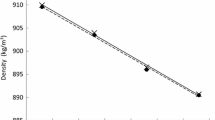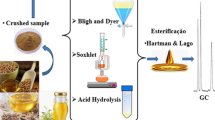Abstract
By varying the extracting conditions, it may be possible to produce high-quality, low-phosphorus and low-free fatty acid (FFA) oil extracted from water or mechanically damaged soybeans. The variability in phospholipids and FFA was studied in oil extracted by an alternative process from undamaged, damaged and aged soybeans subjected to various changes. Forrest and Hutcheson cultivars were used, and extractions were from finely ground flour rather than from flakes. Freezing caused the maximum increase in FFA and phosphorus levels compared to other levels in damaged or undamaged soybeans, but the levels were reasonable compared to flake extraction. Phosphorus and FFA increased when storage temperatures went from 25 to 45°C, extraction temperatures from 25 to 50°C and moisture of the flour from 6 to 10%. However, the storage time of soybeans with initially high moisture (20%) did not have a marked influence on FFA and phosphorus levels. Immediately after grinding moisture of the flour elevated or lowered the phosphorus level to a great extent, although it had little influence on the FFA level. Phosphatidic acid and phosphatidylcholine were identified as the main phospholipids present when total phosphorus was low in extracted oil. The time taken for the flour to dry to 6% moisture (after grinding and before it was extracted) was critical. The alternative extraction process moderated the expected increase in FFA and phospholipids as the result of soybean damage.
Similar content being viewed by others
References
Sternberg, K.J., L.S. Wei, and A.I. Nelson,J. Am. Oil Chem. Soc. 67:308 (1990).
Priestly, D.A., and A.C. Leopold,Plant Physiol. 59:467 (1983).
Velasco, J., and A.A. Abdul Baki,J. Am. Oil Chem. Soc. 56:970 (1979).
Meloy, G.S.,Oil and Soap 16:174 (1939).
Acker, L.W.,Food Technol. 23:27 (1969).
Robertson, J.A., W.H. Morrison III and D. Burdick,J. Am. Oil Chem. Soc. 50:443 (1973).
Clark, P.K., and H.E. Snyder,:814 (1991).
Snyder, H.E., G. Sheu, H.G. Brown, P. Clark and K.L. Wiese,:255 (1988).
Walde, P., and C. Nastruzzi,Food Chem. 39:249 (1991).
Bartlett, G.R.,J. Biol. Chem. 234:466 (1959).
Touchstone, J.C., J.C. Chen and K. Beaver,Lipids 15:61 (1980).
Official and Tentative Methods of the American Oil Chemists’ Society, edited by R.C. Walker, American Oil Chemists’ Society, Champaign, 1985.
Jaworski, J.C., inLipids: Structure and Function, edited by P.K. Stumpf, Academic Press Inc., Orlando, 1980.
Author information
Authors and Affiliations
About this article
Cite this article
Adhikari, C., Snyder, H.E., Kwon, T.W. et al. Alternative extraction effects on the free fatty acids and phosph in oil from damaged and undamaged soybeans. J Am Oil Chem Soc 69, 1141–1145 (1992). https://doi.org/10.1007/BF02541051
Received:
Accepted:
Issue Date:
DOI: https://doi.org/10.1007/BF02541051




